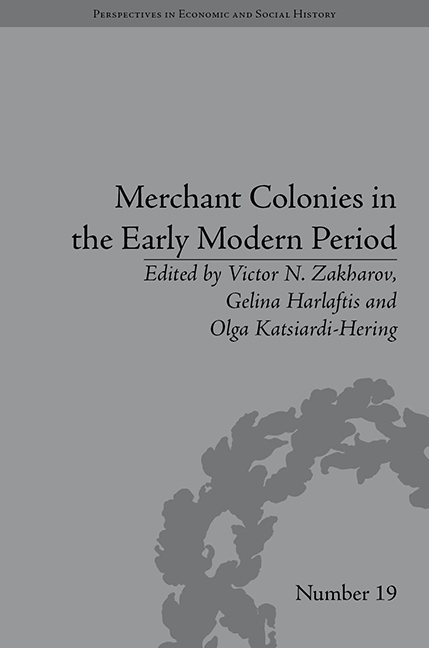Book contents
- Frontmatter
- Contents
- List of Figures and Tables
- List of Contributors
- Introduction
- 1 Early Modern English Merchant Colonies: Contexts and Functions
- 2 German and Italian Merchant Colonies in Early Modern England
- 3 Dynamism and Integration of the North European Merchant Communities in French Ports in the Eighteenth Century
- 4 Opportunity and Legislation: How the Armenians Entered Trade in Three Mediterranean Ports
- 5 Russian Merchant Colonies in Seventeenth-Century Sweden
- 6 Foreign Merchant Communities in Eighteenth-Century Russia
- 7 Greek Merchant Colonies in Central and South-Eastern Europe in the Eighteenth and Early Nineteenth Centuries
- 8 Community for Commerce: An Introduction to the Nezhin Greek Brotherhood Focusing on its Establishment as a Formal Institution in the Years Between 1692 and 1710
- 9 Entrepreneurship at the Russian Frontier of International Trade. The Greek Merchant Community/Paroikia of Taganrog in the Sea of Azov, 1780s–1830s
- Notes
- Index
4 - Opportunity and Legislation: How the Armenians Entered Trade in Three Mediterranean Ports
- Frontmatter
- Contents
- List of Figures and Tables
- List of Contributors
- Introduction
- 1 Early Modern English Merchant Colonies: Contexts and Functions
- 2 German and Italian Merchant Colonies in Early Modern England
- 3 Dynamism and Integration of the North European Merchant Communities in French Ports in the Eighteenth Century
- 4 Opportunity and Legislation: How the Armenians Entered Trade in Three Mediterranean Ports
- 5 Russian Merchant Colonies in Seventeenth-Century Sweden
- 6 Foreign Merchant Communities in Eighteenth-Century Russia
- 7 Greek Merchant Colonies in Central and South-Eastern Europe in the Eighteenth and Early Nineteenth Centuries
- 8 Community for Commerce: An Introduction to the Nezhin Greek Brotherhood Focusing on its Establishment as a Formal Institution in the Years Between 1692 and 1710
- 9 Entrepreneurship at the Russian Frontier of International Trade. The Greek Merchant Community/Paroikia of Taganrog in the Sea of Azov, 1780s–1830s
- Notes
- Index
Summary
‘The whole country between Erevan and Tabriz was ruined by Shah Abbas … he wanted to make the country a desert and took the inhabitants of Julfa and its vicinity, young and old, fathers, mothers, children, with whom he made diverse colonies in his kingdom. He sent up to twenty seven thousand families to the Province of Guilan, where silk is made, the terrible climate there killed many of these people accustomed to a gentler climate. The most important [of the region of Julfa] were sent to Ispahan, where the king pushed them to trade, he advanced them the raw silk, which they paid on their return, which quickly made them thrive. The king gave them grand privileges, among others they had their own Chief, their own Judges without depending on the justice of Persia … there they built the town of Julfa, which they call Julfa the New.’
Jean Baptiste TavernierFree ports and favourable legislation were the open doors through which the Armenians and other foreign merchants settled in several ports in the Mediterranean. Arriving mostly from the Ottoman Empire's markets of Smyrna and Aleppo, which were crucial to their silk trade, but many were not Ottoman Armenians, but New Jufan American merchants, who had their trading centre in Iran. Although they had a presence in other Mediterranean ports, the three major settlements for both the Julfan and Ottoman Armenians were Venice, Livorno and Marseille.
- Type
- Chapter
- Information
- Merchant Colonies in the Early Modern Period , pp. 61 - 84Publisher: Pickering & ChattoFirst published in: 2014



